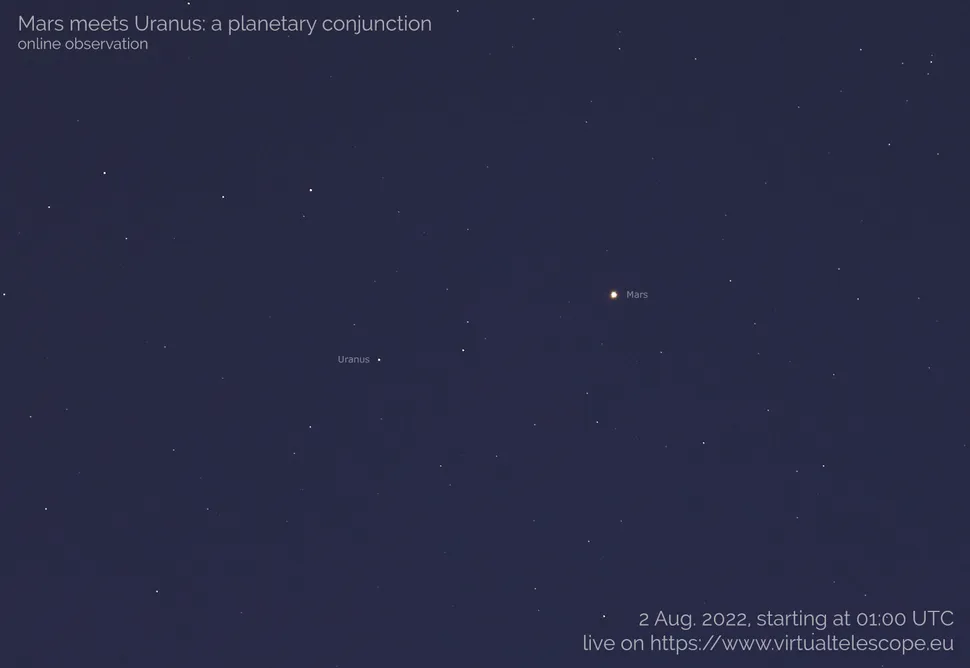
'Mars and Uranus are night-sky neighbors at the moment, and you can get good views of their unusual meetup online tonight (Aug. 1).
The two planets are close enough in the sky right now to be seen together through binoculars or a low-power telescope. But even if you don't have such gear, you can still get good looks at in a webcast tonight.
The Virtual Telescope Project, which is run by Italian astrophysicist Gianluca Masi, will stream views of Mars and Uranus tonight, beginning at 9 p.m. EDT (0100 GMT on Aug. 2). You can watch live here at Space.com or directly at the Virtual Telescope Project (opens in new tab).
Mars and Uranus have been approaching each other in our sky for a while now. Their rendezvous will peak tomorrow (Aug. 2), when the two planets will be separated by just 1.5 degrees. (Reminder: Your clenched fist held at arm's length covers about 10 degrees of sky.)
Though Uranus is much bigger than Mars, the Red Planet appears far brighter in our sky because of its relative proximity to Earth and to the sun. The bluish green Uranus is currently shining at roughly magnitude 5.8, whereas Mars checks in at about 0.2. (On the logarithmic magnitude scale that astronomers use, lower numbers denote brighter objects. For comparison, the brightest planet in our sky, Venus, shines with a maximum magnitude of about -4.6 (opens in new tab).)
[...]'
-Mike Wall

https://www.space.com/mars-uranus-conjunction-2022-webcast
'Scientists expect such massive collisions were more common in the early Solar System, indeed they are part of the story of how all planets are thought to form. But Uranus must have experienced impacts that were very different from Earth simply because Uranus formed so much farther from the Sun.
[...]
Because the temperature at which water ice forms is low, the impact debris from Uranus and its icy impactor would have mostly vapourised during the collision. [...] In the case of Uranus, a large icy impactor was able to tilt the planet, give it a rapid rotation period (Uranus' 'day' is presently ~ 17 hours, even faster than Earth's), and the leftover material from the collision remained gaseous longer. The largest mass body, what would become Uranus, then collected most of the leftovers, and thus Uranus' present moons are small. To be precise, the ratio of Uranus' mass to Uranus' moons' masses is greater than the ratio of Earth's mass to its moon by a factor of more than a hundred. Ida and colleagues' model beautifully reproduces the current configuration of Uranus' satellites.
As Professor Ida explains, 'This model is the first to explain the configuration of Uranus' moon system, and it may help explain the configurations of other icy planets in our Solar System such as Neptune. Beyond this, astronomers have now discovered thousands of planets around other stars, so-called exoplanets, and observations suggest that many of the newly discovered planets known as super-Earths in exoplanetary systems may consist largely of water ice and this model can also be applied to these planets.'
-Tokyo Institute of Technology
https://www.sciencedaily.com/releases/2020/04/200406092843.htm
'[...]
Neptune and Uranus have much in common -- they have similar masses, sizes, and atmospheric compositions -- yet their appearances are notably different. At visible wavelengths Neptune has a distinctly bluer color whereas Uranus is a pale shade of cyan. Astronomers now have an explanation for why the two planets are different colors.
[...]
"This is the first model to simultaneously fit observations of reflected sunlight from ultraviolet to near-infrared wavelengths," explained Irwin, who is the lead author of a paper presenting this result in the Journal of Geophysical Research: Planets. "It's also the first to explain the difference in visible color between Uranus and Neptune."
The team's model consists of three layers of aerosols at different heights. The key layer that affects the colors is the middle layer, which is a layer of haze particles (referred to in the paper as the Aerosol-2 layer) that is thicker on Uranus than on Neptune. The team suspects that, on both planets, methane ice condenses onto the particles in this layer, pulling the particles deeper into the atmosphere in a shower of methane snow. Because Neptune has a more active, turbulent atmosphere than Uranus does, the team believes Neptune's atmosphere is more efficient at churning up methane particles into the haze layer and producing this snow. This removes more of the haze and keeps Neptune's haze layer thinner than it is on Uranus, meaning the blue color of Neptune looks stronger.
"We hoped that developing this model would help us understand clouds and hazes in the ice giant atmospheres," commented Mike Wong, an astronomer at the University of California, Berkeley, and a member of the team behind this result. "Explaining the difference in color between Uranus and Neptune was an unexpected bonus!"
[...]'
-Association of Universities for Research in Astronomy (AURA)
https://www.sciencedaily.com/releases/2022/05/220531140128.htm
